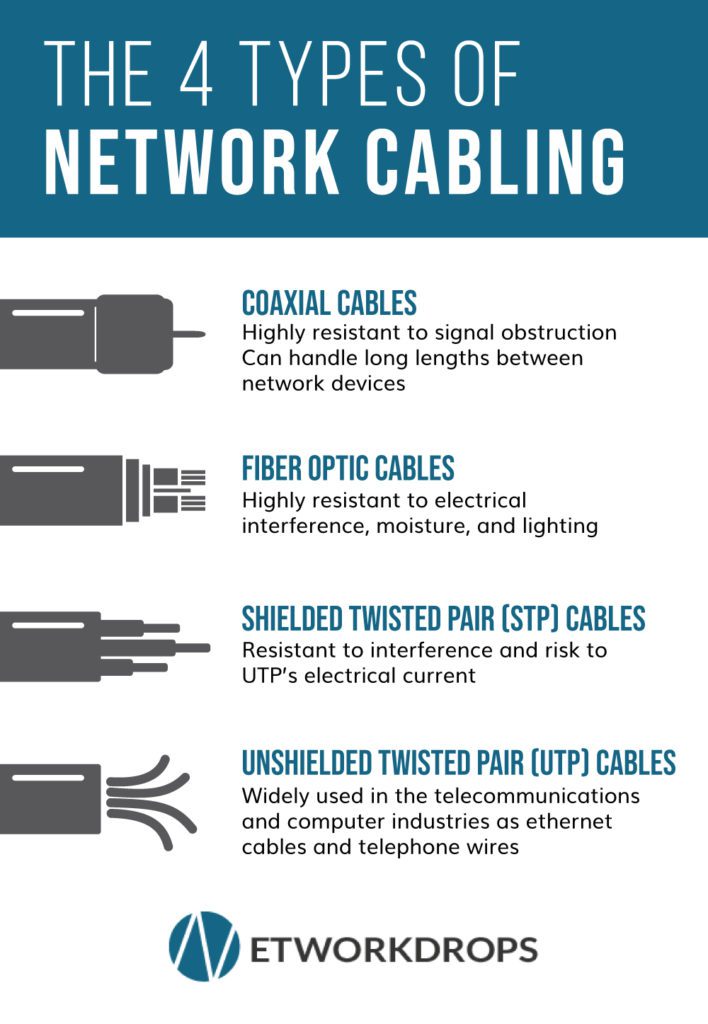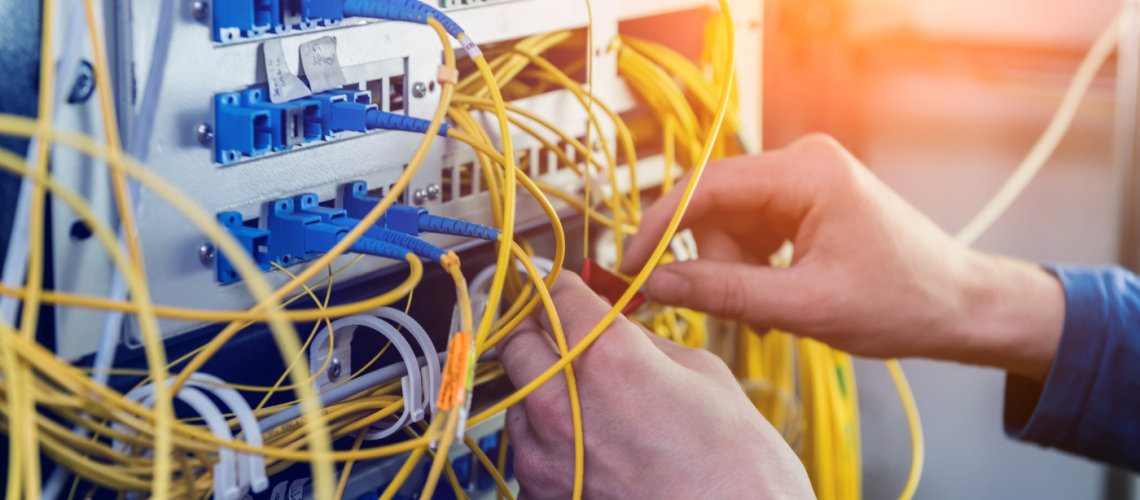Introduction
Modern communication systems are based on network cabling, which facilitates data transfer between devices. Choosing the right kind of network cable is essential for reliable connectivity and top performance in this digital age. In this article, we explore the features, uses, and deployment considerations of the four main categories of network cabling.
What is network cabling & its use
Networking cables are a type of networking hardware used to connect a network device to one or more other network devices, or to connect two or more devices to a single computer or network device.
Network cables act as a medium through which information and data travel from one network device to another. The type of cable used for a network depends on the network’s topology, size, and procedure. The different types of network cables act as the supporting basis of the network infrastructure.

Selecting the correct type of network and ethernet cabling can affect many different business functions because enterprise network admins utilize new technologies. The type of network cable used in a network infrastructure is one of the most vital aspects of networking across various industries.
Different 4 Types of Network Cables
Coaxial Cable
Coaxial cables have a single copper conductor at the center, while a plastic layer provides insulation between the center conductor and braided metal shield. The metal shield blocks outside interference from fluorescent lights, motors, and other computers.
Coaxial cabling is highly resistant to signal obstruction, although it can be complex to install. It can handle greater cable lengths between network devices than twisted pair cables. The two types of coaxial cables are thick coaxial and thin coaxial.
-
Single core Coaxial Cable
A center copper conductor encircled by insulating material and a braided metal shield makes up a single-core coaxial cable. Reliable data transmission is ensured by this design’s effective blocking of outside interference. Single-core coaxial cables’ longevity and long-range signal transmission capabilities are well recognized. They are frequently utilized in applications, including standard Ethernet networks, broadband internet connections, and cable television systems. Single-core coaxial cables are an excellent option for situations where dependable data transfer is crucial because of their sturdy design and resistance to signal obstruction.
-
Multi core Coaxial Cable
Multi-core coaxial cables feature multiple copper conductors arranged within a single cable structure, each surrounded by insulation and a shared braided metal shield. This architecture is efficient for applications requiring large bandwidths or numerous channels since it permits the simultaneous transmission of multiple signals or data streams over a single wire. When it’s necessary to transmit a variety of signals or data kinds, multi-core coaxial cables are frequently used in networking, broadcasting, and telecommunications scenarios. Multi-core coaxial cables are crucial parts of modern communication systems because of their adaptability and ability to handle various messages.
Coaxial cables in computer networks
Coaxial cables are essential to computer networks because they make data transfer between devices more dependable and effective. Coaxial cables efficiently reduce signal interference by using a single copper conductor at the core and a shield to ensure reliable performance. They are the foundation for local area networks (LANs) and wide area networks (WANs), linking PCs to routers, switches, and modems. Coaxial cables are perfect for data-intensive applications like file sharing, online gaming, and video streaming since they perform well in areas where electromagnetic interference is common. Coaxial cables offer a reliable and strong connectivity option for computer networks.
Fiber Optic Cable
Fiber optic cables possess a center glass core surrounded by multiple layers of protective materials. They avoid electrical obstruction by transmitting light instead of electronic signals, making them perfect for environments with large amounts of electrical interference. Fiber optic cables have become the standard for connecting networks across buildings because of their resistance to moisture and lighting.
-
SMF (Single-mode fiber) optical cable
Single-mode fiber (SMF) optical cables consist of a narrow glass core surrounded by layers of protective material, enabling the transmission of light signals over long distances with minimal signal loss. SMF cables offer high bandwidth and are ideal for applications requiring high-speed data transmission over extended distances, such as telecommunications networks, long-haul data connections, and backbone infrastructure. For mission-critical communications and dependable connectivity where performance and dependability are crucial, SMF optical cables are indispensable due to their capacity to preserve signal integrity over extended distances.
-
MMF (multi-mode fiber) optical cable
Multi-mode fiber (MMF) optical cables feature a larger core diameter than single-mode fibers, allowing for the transmission of multiple light signals simultaneously. MMF cables are well-suited for short to medium-distance data transmission applications, offering cost-effective solutions for local area networks (LANs), campus networks, and data center interconnections. With their ability to support high bandwidth over relatively shorter distances, MMF optical cables are commonly deployed in environments where space and budget constraints are considerations. They provide reliable connectivity for applications such as data transfer, video streaming, and cloud computing, making them integral components of modern network infrastructure.
Shielded Twisted Pair (STP) Cable
Often referred to colloquially as simply ethernet cables, STP cables employ a special type of copper telephone wiring used for business installations. An external shield functioning as a ground is added to the standard twisted pair of telephone wires.
Shielded twisted pair cables can be perfect if you want to set up cables in an area with potential interference and risks to an unshielded twisted pair cable’s electrical current. Shielded twisted pair cables can also help to expand the distance between the cables.
Unshielded Twisted Pair (UTP) Cable
Unshielded twisted pair (UTP) cables are broadly used in the telecommunications and computer industries as ethernet cables and telephone wires. In a UTP cable, conductors forming a single circuit are twisted around one another to cancel out electromagnetic interference (EMI) from external sources.
Different Categories of Network Cables
Network cables are categorized into eight segments, each offering specific features and capabilities to meet varying connectivity needs:
Cat1: Primarily used for wire telephones and modems, Cat1 cables consist of unshielded twisted pair wires. Although basic, they provide essential connectivity for voice communication.
Cat2: Commonly utilized in the 1980s for telephones and ring networks, Cat2 cables served as an upgrade from Cat1, offering slightly improved performance.
Cat3: Emerging in the early 1990s, Cat3 cables became prevalent as ethernet cables. They feature four twisted pairs of wires and are commonly found in older buildings, supporting basic data transmission.
Cat4: Similar to Cat3, Cat4 cables are often found in older infrastructure and were primarily used for token ring networks.
Cat5: Introduced in the mid-1990s, Cat5 cables brought fast ethernet capabilities, providing higher speeds and improved resistance to interference compared to earlier categories.
Cat6: Offering enhanced data transfer rates over Cat5, Cat6 cables are utilized in commercial buildings requiring Gigabit ethernet connectivity. Cat6a, introduced in 2009, further enhances Cat6’s capabilities.
Cat7: Providing a robust infrastructure, Cat7 cables offer improved performance and shielding compared to previous categories. Cat7a, a refined version, can transmit data at speeds up to 40 Gigabits per second.
Cat8: With conductors wrapped in foil, Cat8 cables enable even higher data rates, making them suitable for demanding applications in modern networks. They offer advanced performance and reliability for high-speed data transmission.
Are you looking for your own data cabling installation for Monmouth or Mercer Counties? If so, don’t hesitate to give our team a call today!
FAQ-
Q1. What network cable should I use?
The choice of network cable depends on factors such as the network topology, environment, bandwidth requirements, and budget. Consultation with network professionals can help determine the most suitable option for your needs.
Q2. What are types of data cabling?
Data cabling encompasses various types, including coaxial cables, fiber optic cables, shielded twisted pair (STP) cables, and unshielded twisted pair (UTP) cables. Each type offers unique characteristics and is suited to different networking applications.
Q3. What are the different types of network cabling?
The primary types of network cabling include coaxial cables, fiber optic cables, shielded twisted pair (STP) cables, and unshielded twisted pair (UTP) cables. Each type serves specific purposes and exhibits distinct advantages in terms of performance and reliability.
Q4. What are the 5 networking cable category?
The five networking cable categories, commonly called CAT cables, are CAT5, CAT5e, CAT6, CAT6A, and CAT7. These categories define the cable’s performance characteristics, including bandwidth, maximum frequency, and crosstalk mitigation.
Q5. Does CAT6 use all 8 wires?
Yes, CAT6 cables typically utilize all eight wires within the twisted pair configuration to support higher bandwidth and data transmission speeds compared to earlier categories such as CAT5 and CAT5e.

